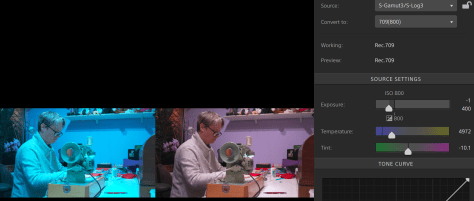 Wireless video transmitters are nothing new and there are lots of different units on the market. But the Accsoon CineEye 2S stands out from the crowd for a number of reasons.
Wireless video transmitters are nothing new and there are lots of different units on the market. But the Accsoon CineEye 2S stands out from the crowd for a number of reasons.
First is the price, at only £220/$300 USD it’s very affordable for a SDI/HDMI wireless transmitter. But one thing to understand is that it is just a transmitter, there is no reciever. Instead you use a phone or tablet to receive the signal and act as your monitor. You can connect up to 4 devices at the same time and the latency is very low. Given that you can buy a reasonably decent Android tablet or used iPad for £100/$140 these days, it still makes an affordable and neat solution without the need to worry about cables, batteries or cages at the receive end. And most people have an iPhone or Android phone anyway. The Accsoon app includes waveform and histogram display, LUT’s, peaking and all the usual functions you would find on most pro monitors. So it saves tying up an expensive monitor just for a directors preview. You can also record on the tablet/phone giving the ability for the director or anyone else linked to it to independently play back takes as he/she wishes while you use the camera for other things.

Next is the fact that it doesn’t have any fans. So there is no additional noise to worry about when using it. It’s completely silent. Some other units can get quite noisy.
And the best bit: If you are using an iPhone or iPad with a mobile data connection the app can stream your feed to YouTube, Facebook or any similar RMTP service. With Covid still preventing travel for many this is a great solution for an extremely portable streaming solution for remote production previews etc. The quality of the stream is great (subject to your data connection) and you don’t need any additional dongles or adapters, it just works!
Watch the video, which was streamed live to YouTube with the CineEye 2S for more information. At 09.12 I comment that it uses 5G – What I mean is that it has 5Ghz WiFi as well as 2.5Ghz Wifi for the connection between the CineEye and the phone or tablet. 5Ghz WiFi is preferred where possible for better quality connections and better range. https://accsoonusa.com/cineeye/
 With the new FX6 making use of SD cards to record higher bit rate codecs the number of gigabytes of SD card media that many user will will be getting through is going to be pretty high. The more gigabytes of memory that you use, the more the chance of coming across a duff memory cell somewhere on your media.
With the new FX6 making use of SD cards to record higher bit rate codecs the number of gigabytes of SD card media that many user will will be getting through is going to be pretty high. The more gigabytes of memory that you use, the more the chance of coming across a duff memory cell somewhere on your media.

























